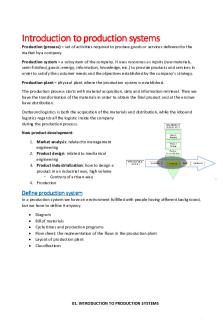Chapter 01 introduction to pathphysiology PDF

| Title | Chapter 01 introduction to pathphysiology |
|---|---|
| Course | Pharmacology |
| Institution | Chamberlain University |
| Pages | 2 |
| File Size | 44.6 KB |
| File Type | |
| Total Downloads | 86 |
| Total Views | 153 |
Summary
Download Chapter 01 introduction to pathphysiology PDF
Description
Chapter 01: Introduction to Pathophysiology 1. Which of the following would be the most likely cause of an iatrogenic disease? An unwanted effect of a prescribed drug. 2. The manifestations of a disease are best defined as the: signs and symptoms of a disease. 3. The best definition of the term prognosis is number of remissions to be expected during the course of a chronic illness. predicted outcome or likelihood of recovery from a specific disease. 4. Which of the following is considered a systemic sign of disease? Swelling of the Fever 5. Etiology is defined as the study of the: causes of a disease. 6. A type of cellular adaptation in which there is a decrease in cell size is referred to as: atrophy. 7. A change in a tissue marked by cells that vary in size and shape and show increased mitotic figures would be called: dysplasia. 8. A deficit of oxygen in the cells usually due to respiratory or circulatory problems is called: ischemia. 9. When a group of cells in the body dies, the change is called: necrosis. 10. Rigorous weight lifting/body building regimens may result in the skeletal muscle cells undergoing: hypertrophy. 11. The term cancer refers to: malignant neoplasm. 12. To which of the following does the term apoptosis refer? Preprogrammed cell self-destruction 13. Which of the following statements is TRUE? Damaged cells may be able to repair themselves. 14. Caseation necrosis refers to an area where: dead cells form a thick cheesy substance. 15. Routine application of sun block to skin would be an example of: a preventive measure. 16. A circumstance that causes a sudden acute episode of a chronic disease to occur is termed: precipitating factor. 17. The term homeostasis refers to: maintenance of a stable internal environment. 18. Which term is used to describe a new and secondary or additional problem that arises after the original disease has been established? Complication 19. Pathophysiology involves the study of: functional or structural changes resulting from disease processes. 20. Which of the following is the best definition of epidemiology? The science of tracking the occurrence and distribution of diseases 21. All of the following can cause cell injury or death: Hypoxia, Exposure to excessive cold, Excessive pressure on a tissue and Chemical toxins. 22. All of the following are part of the Seven Steps to Health EXCEPT: participate in strenuous exercise on a regular daily basis. 23. The term disease refers to: a deviation from the normal state of health and function. 24. A collection of signs and symptoms, often affecting more than one organ or system, that usually occur together in response to a certain condition is referred to as a (an): syndrome. 25. All of the following statements are correct about cell damage EXCEPT: Initially, cell damage does not change cell metabolism, structure, or function. 26. Which of the following conditions distinguishes double blind studies used in health research? Neither the members of the control group or the experimental group nor the person administering the treatment knows who is receiving the experimental therapy. 27. If the data collected from the research process confirm that the new treatment has increased effectiveness and is safe, this is called: evidence-based research. 28. A short-term illness that develops very quickly with perhaps a high fever or severe pain is called: acute. 29. The term prognosis refers to the: expected outcome of the disease. 30. When prolonged ischemia occurs to an area of the heart, the resulting damage is referred to as: infarction.
31. During the evaluation process for a new therapy’s effectiveness and safety, a double blind study may be conducted during: the third stage. 32. Why are the predisposing factors for a specific disease important to health professionals? To develop preventive measures 33. Cell damage may be caused by exogenous sources such as: certain food additives. 34. The following are usually included in a medical history: Past illnesses or surgeries, Current illnesses, acute and chronic, Prescribed medication or other treatments, Nonprescription drugs and herbal remedies and Current allergies. 35. A situation when there is a higher than expected number of cases of an infectious disease within a given area is called a/an: epidemic. 36. The term pathogenesis refers to: the development of a disease or sequence of events related to tissue changes involved in the disease process....
Similar Free PDFs

Chapter 01 - Introduction to Android
- 34 Pages

01 Introduction to Management
- 18 Pages

01 Introduction
- 3 Pages
Popular Institutions
- Tinajero National High School - Annex
- Politeknik Caltex Riau
- Yokohama City University
- SGT University
- University of Al-Qadisiyah
- Divine Word College of Vigan
- Techniek College Rotterdam
- Universidade de Santiago
- Universiti Teknologi MARA Cawangan Johor Kampus Pasir Gudang
- Poltekkes Kemenkes Yogyakarta
- Baguio City National High School
- Colegio san marcos
- preparatoria uno
- Centro de Bachillerato Tecnológico Industrial y de Servicios No. 107
- Dalian Maritime University
- Quang Trung Secondary School
- Colegio Tecnológico en Informática
- Corporación Regional de Educación Superior
- Grupo CEDVA
- Dar Al Uloom University
- Centro de Estudios Preuniversitarios de la Universidad Nacional de Ingeniería
- 上智大学
- Aakash International School, Nuna Majara
- San Felipe Neri Catholic School
- Kang Chiao International School - New Taipei City
- Misamis Occidental National High School
- Institución Educativa Escuela Normal Juan Ladrilleros
- Kolehiyo ng Pantukan
- Batanes State College
- Instituto Continental
- Sekolah Menengah Kejuruan Kesehatan Kaltara (Tarakan)
- Colegio de La Inmaculada Concepcion - Cebu












